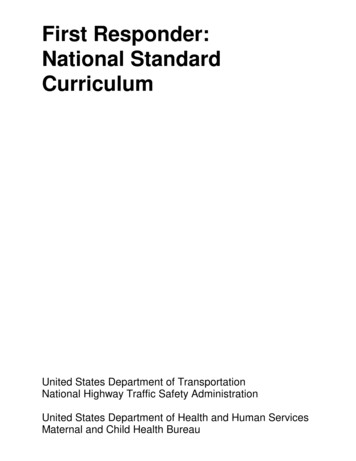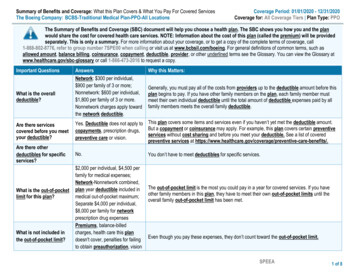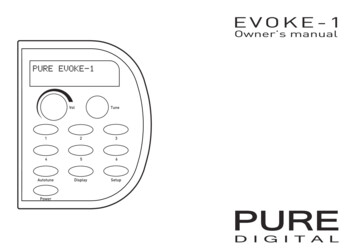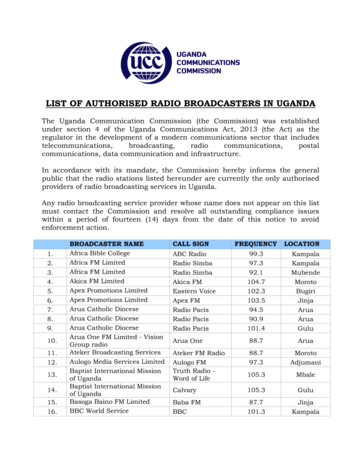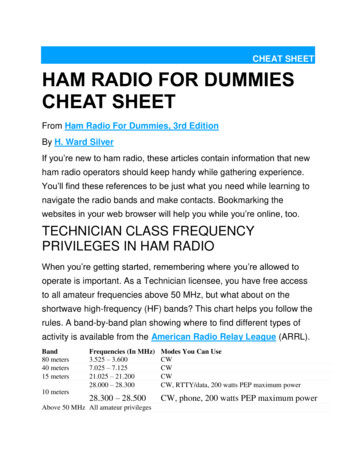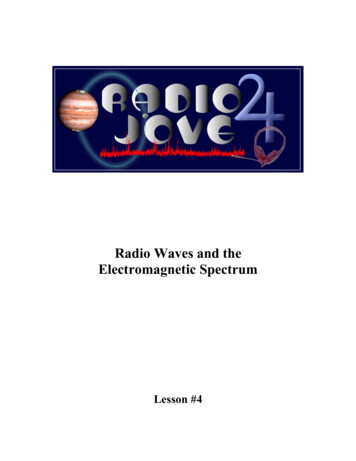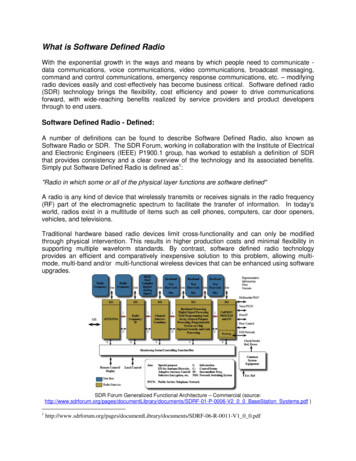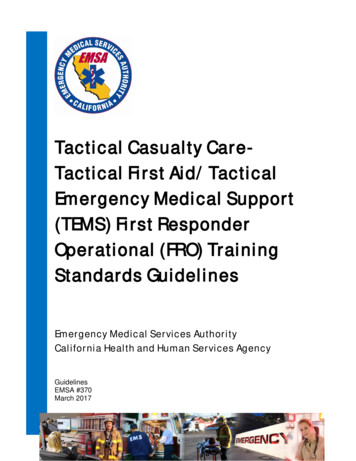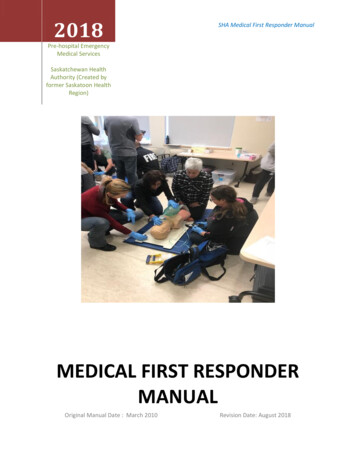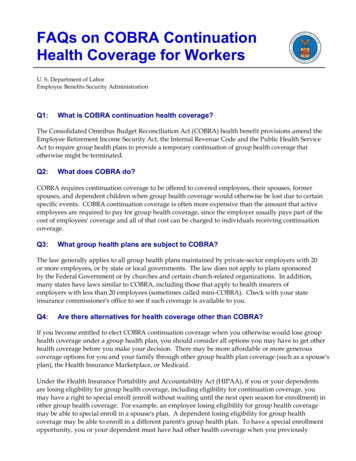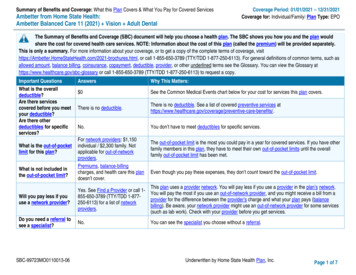
Transcription
“First Responder Radio CoverageCode Requirements, TestProcedures and AmplificationSystem Requirements”Steve Wheeler, RCDD – JDRM Engineering, Inc.
When Did We RealizeThere Was a Problem?The events of 9/11 brought the need forreliable radio coverage to the forefrontof our nation’s conscience.
Current Code Requirements forNew Buildings
International Building Code Section 915(2012), 916 (2015), and 918 (2018)916.1 General. Emergency responder radio coverageshall be provided in all new buildings in accordancewith Section 510 of the international fire code.Local jurisdictions and states may modify this.
Variations of Code inOther States 3 stories or more 5,000 square foot or more You impede your neighbor, youpay to fix their system Third party independent testing
International Fire CodeSection 510-2017510.1 Emergency responder radio coverage in new buildings. Allnew buildings shall have approved radio coverage for emergencyresponders within the building based upon the existing coverage levelsof the public safety communication systems of the jurisdiction at theexterior of the building. This paragraph shall not require improvementof the existing public safety communication systems.Also in NFPA 11.10.1
IFC Section 510-2017Exceptions:1. Where approved by the building official and the fire codeofficial, a wired communication system in accordance withParagraph (G)(2)(m)(ii) of Rule 1301:7-7-09 of theAdministrative Code 907.2.13.2 shall be permitted to be installedor maintained in lieu of an approved radio coverage system.
IFC Section 510Exceptions:2. Where it is determined by the fire code official thatthe radio coverage system is not needed.Where, When, Why?
IFC Section 510Exceptions:3. In facilities where emergency responder radio coverage isrequired and such systems, components or equipment requiredcould have a negative impact on the normal operations of thatfacility, the fire code official shall have the authority to accept anautomatically activated emergency responder radio coveragesystem.NFPA 11.10.3
Current Code Requirementsfor Existing Buildings
IFC Section 510510.2 Emergency responder radio coverage in existingbuildings. Existing buildings shall be provided withapproved radio coverage for emergency responders asrequired in Rule 1301:7-7-11 of the AdministrativeCode.
Rule 1301:7-7-11 Administrative Code(1) 1101.1 Scope. The provisions of this rule shall apply toexisting buildings constructed prior to the adoption of this code inaccordance with paragraph (B)(1)(c)(102.1) of rule 1301:7-7-01of the Administrative Code. The provisions of this rule shall notapply to existing buildings unless the conditions at the buildingconstitute a distinct hazards to life or property in the opinion ofthe fire code official in accordance with paragraph(B)(1)(c)(102.1) of rule 1301:7-7-01 of the Administrative Code.
What else triggers a test?When structural changes occur includingadditions or remodels that could materiallychange the original field performance.(IFC 510.6.1 – Technically under maintenance)
The Role of theFire Code OfficialAbility to waive the requirement –When and why would this be applicable?
IFC Section 510510.4.2.2 Technical Criteria. The fire code official shall maintain adocument providing the specific technical information andrequirements for the emergency responder radio coverage system. Thisdocument shall contain, but not be limited to, the various frequenciesrequired, the location of radio sites, effective radiated power of radiosites, and other supporting technical information.(Similar to NFPA 72 - 24.5.2.4.1 & NFPA 1221-9.6.14)
Signal Strengthand CoverageRequirements
IFC Section 510(2) 510.4.1 Radio signal strength. The buildingshall be considered to have acceptableemergency responder radio coverage whensignal strength measurements in 95 percent of allareas on each floor of the building meet thesignal strength requirements in Sections510.4.1.1 and 510.4.1.2.
IFC Section 510(a) 510.4.1.1 Minimum signal strength into thebuilding. A minimum signal strength of -95 dBm shallbe receivable within the building.
IFC Section 510(b) 510.4.1.2 Minimum signal strength out of thebuilding. A minimum signal strength of -95 dBm shallbe received by the agency’s radio system whentransmitted from within the building.
What are the requirements forindividuals performing the testing?NONE.In 2015 or 2017 International Fire CodeCheck local codes and ordinances. Some use design criteria as testingcriteria.
What are the requirements forindividuals designing the system?510.5.2 Minimum qualifications of personnel.The minimumqualifications of the system designer and lead installation personnelshall include both of the following:1. A valid FCC-issued General Radio Operators License.2. Certification of in-building system training issued by a nationallyrecognized organization or school OR Certificate issued by themanufacturer of the equipment being installed
These qualifications shall not be requiredwhere demonstration of adequate skills andexperience satisfactory to the fire codeofficial is provided.
What happens ifthe building doesnot pass thetesting?
IFC Section 510510.4.2.1 Amplification Systems Allowed. Buildings and structuresthat cannot support the required level of radio coverage shall beequipped with a radiating cable system or a distributed antennasystem (DAS) with FCC-certified signal boosters, or both, or with asystem that is otherwise approved, in order to achieve the requiredadequate radio coverage.(Also covered in NFPA 72 – 24.5.2.2.3 & NFPA 1221-9.6.7.6)
Who Pays for the Testing?The Building Owner – You!
How Much Does Testing Cost?The cost of testing is dependent on: The number of buildings The number of floors for each building The number of frequencies in use by firstresponders Travel time to and from the site
What aboutfuture changesor re-testing?OFC 510.6.1 states .1. Retest when modifications to building to public agency’sradio system changes.2. Annual in-building test, signal booster test, battery testactive components, and submit a report.
FIRST RESPONDERSIGNAL SURVEYTEST PROCEDURE
Pre-Enhancementvs.Post Enhancement
Pre-Enhancement95% Coverage All Areas on EachFloor IFC 510.41No Criteria for Test Pattern orGranularity
Post EnhancementDivision of Floor90% Coverage All Areas onEach Floor NFPA 1221 9.6.7.599% Critical Areas(Depending on code year)
WHAT ARE THE STANDARDS AND HOW ISTHE TESTING PERFORMED?-95dBm or stronger PASSWeaker than -95dBm FAILIFC 510.4.1.1 & 510.4.1.2Inbound & OutboundConsiderations:Distance and location on antenna towers?Repeaters/boosters, used in vehicles or trucks?Tactical channels, mutual aid and Simplex.
(c) 510.5.3 Acceptance test procedure. Wherean emergency responder radio coverage systemis required and upon completion of installation,the building owner shall have the radio systemtested to verify that two-way coverage on eachfloor of the building is not less than 90 percent.The test procedure shall be conducted as follows:
(i) Each floor of the building shall be divided intoa grid of 20 approximately equal test areas.(ii) The test shall be conducted using a calibratedportable radio of the latest brand and modelused by the agency talking through the agency’sradio communications system.
(v) A test location approximately in the center of eachtest area shall be selected for the test, with theradio enabled to verify two-way communicationsto and from the outside of the building through thepublic agency’s radio communications system.Once the test location has been selected, thelocation shall represent the entire test area. Failurein the selected test location shall be consideredfailure of that test area. Additional test locationsshall not be permitted.
(vi) The gain values of all amplifiers shall bemeasured and the test measurement results shallbe kept on file with the building owner so thatthe measurements can be verified during annualtests. In the event that the measurement resultsbecome lost, the building owner shall be requiredto rerun the acceptance test to re-establish thegain values.
(vii) As part of the installation a spectrum analyzeror other suitable test equipment shall beutilized to ensure spurious oscillations are notbeing generated by the subject signal booster.This test shall be conducted at the time ofinstallation and subsequent annualinspections.
Acceptance Test Procedure Enhanced SystemIFC 510.5.3(1) 90 percent coverage required(2) Max 2 non adjacent shall not result in failure of test(3) If 3 fail, can divide into 40New in 2016NFPA 1221 9.6.7.9 & 9.6.7.5(1) 90 percent except critical areas 99 percent.Critical areas defined as fire command centers, fire pump rooms, exit stairs, exitpassageways, elevator lobbies, standpipe cabinets, sprinkler sectional valve locations,and other areas deemed critical by AHJ.
Step 1: Divide Each Floor into 20 EqualSpaces, as described in IFC 510.5.3Example #1
Step 1: Divide Each Floor into 20 EqualSpaces, as described in IFC 510.5.3Example #22 hour Fire Separation walls or NFPA-72 Ch. 14-A14.4.10.3 (128,000 sq. ft.)
Step 2: Test Each SpaceStep 2a: Measure signal levels with test equipment.Spectrum AnalyzerSignal levels weaker than -95 dBM FAILScanning Receiver
Spectrum Analyzer Examples:PASSFAIL
NFPA 1221 DAQ Allowed9.6.8.2 Outbound.A minimum outbound strength sufficient to provide usable voicecommunications, as specified by the AHJ, shall be providedthroughout the coverage area. The outbound signal level shall besufficient to provide a minimum of DAQ 3.0 for either analog ordigital signals.
Step 2b: Measure DAQ voice QualityVOICE QUALITY MEASURED USING THE DELIVERED AUDIO QUALITY(DAQ) STANDARD:DAQ 1:DAQ 2:DAQ 3:DAQ 3.4:DAQ 4:DAQ 4.5:DAQ 5:Unusable. Speech present, but not understandable.Speech understandable with considerable effort.Requires frequent repetition due to noise or distortion.Speech understandable with slight effort. Requiresoccasional repetition due to noise or distortion.Speech understandable without repetition. Some noiseor distortion present.Speech easily understandable; little noise or distortion.Speech easily understandable; rare noise or distortion.Perfect; no distortion or noise discernible.
Example Test Results:
2018 IFC Section 510510.4.1.1 Minimum signal strength into the building.The minimum inbound signal strength shall be sufficient to provide usable voicecommunications throughout the coverage area as specified by the fire codeofficial. The inbound signal level shall be sufficient to provide not less than aDelivered Audio Quality (DAQ) of 3.0 or an equivalent Signal-to-Interface-PlusNoise Radio (SINR) applicable to the technology for either analog or digitalsignals.
2018 IFC Section 510510.4.1.2 Minimum signal strength out of the building.The minimum outbound signal strength shall be sufficient toprovide usable voice communications throughout the coverage areaas specified by the fire code official. The outbound signal level shallbe sufficient to provide not less than a DAQ of 3.0 or an equivalentSINR applicable to the technology for either analog or digitalsignals.
IN-BUILDINGAMPLIFICATION SYSTEMDESIGN, INSTALLATION,AND WHAT THE CODEREQUIRES
Prior to 2016, requirements found in NFPA 72 Chapter 24.Starting in 2016, Chapter 24 moved to NFPA 1221.Does your State code reference 1221?
BI-DIRECTION AMPLIFIER(BDA) DESIGN
NFPA 72 (2013)24.5.4 System Radio Frequencies. Thepublic safety radio enhancement system shallbe capable of transmitting all public safetyradio frequencies assigned to the jurisdictionand be capable of using any modulationtechnology.
Signal Booster Components
NFPA 72 (2013)/NFPA 1221 (2017)24.5.2.5.2/9.6.11.2 Component Enclosures. All repeater, transmitter,receiver, signal booster components, and battery system componentsshall be contained in NEMA 4- or 4X-type enclosure(s).In 2018, IFC Battery will be reduced to NEMA 3R.24.5.2.5.4 Signal Booster Components/9.6.11.3 RF EmittingDevices. If used, signal boosters shall meet the following requirements,as well as any other requirements determined by the authority havingjurisdiction.
NFPA 72 24.5.2.5.4/NFPA 1221 9.6.11.3 SignalBooster Components (cont.)NFPA72(1) Signal boosters shall have FCC certification prior toinstallation.NFPA 1221 9.6.11.3(1) RF Emitting devices shall have the certification ofthe radio licensing authority (FCC Part 47, CFR Part90.219 per OFC 510.5.4) prior to installation.
NFPA 72 24.5.2.5.4/NFPA 1221 9.6.11.3 SignalBooster Components (cont.)NFPA 72 24.5.2.5.4(2) All signal boosters shall be compatible with bothanalog and digital communicationssimultaneously at the same time of installation.The authority having jurisdiction shall providethe maximum acceptable propagation delaystandard.
2018 IFC Section 510510.4.2.4 Signal booster requirements.If used, signal boosters shall meet the following requirements:1. All signal booster components shall be contained in a National ElectricalManufacturer’s Association (NEMA) 4-type waterproof cabinet.2. Battery systems used for the emergency power source shall be contained in a NEMA3R or higher-rated cabinet.3. Equipment shall have FCC or other radio licensing authority certification and besuitable for public safety use prior to installation.4. Where a donor antenna and all inside antennas to not less than 20dB greater than thesystem gain under all operating conditions.5. Bi-Directional Amplifiers (BDAs) used in emergency responder radio coveragesystems shall have oscillation prevention circuitry.6. The installation of amplification systems or systems that operate on or provide themeans that cause interference on any emergency responder radio coverage networksshall be coordinated and approved by the fire code official.
IFC Section 510(v)510.4.2.5 Additional frequencies and change offrequencies. The emergency responder radio coveragesystem shall be capable of modification or expansion inthe event frequency changes are required by the “FCC” oradditional frequencies are made available by the “FCC”.
NFPA 12219.6.9 Isolation.If a donor antenna exists, isolation shall be maintained betweenthe donor antenna and all inside antennas to a minimum of 20 dBunder all operating conditions.
IFC Section 510510.4.2.8 Radio communication antenna density.Systems shall be engineered to minimize the near-far effect. Radio enhancementsystem designs shall include sufficient antenna density to address reduced gainconditions.Exceptions:1. Class A narrowband signal booster devices with independentACG/ALC circuits per channel.2. Systems where all portable devices within the same band use activepower control features.
PowerRequirements
NFPA 72 (2013)/NFPA 122124.5.2.5.5 Power Supplies. At least two independent andreliable power supplies shall be provided for all repeater,transmitter, receiver, and signal booster components, oneprimary and one secondary.24.5.2.5.5.1 Primary Power Source. The primary power sourceshall be supplied from a dedicated branch circuit and complywith NFPA 72 10.6.5.1.*NFPA 1221 RF Emitting devices and any other components ofthe system.
NFPA 72 (2013)/NFPA 122124.5.2.5.5.2 Secondary Power Source. Thesecondary power source shall consist of one of thefollowing:(I) A storage battery dedicated to the system with at least12 hours of 100 percent system operation capacityand arranged in accordance with 10.6.10*Not in NFPA 1221
NFPA 72(2) An automatic-starting, engine-driven generator serving thededicated branch circuit or the system with at least 12 hours of 100percent system operation capacity and storage batteries dedicated to thesystem with at least 2 hours of 100 percent system operation capacityand arranged in accordance with 10.6.11.3NFPA 1221(2)An alternative power source of 12 hours at 100 percent systemoperation capacity as approved by the authority having jurisdiction.
MonitoringRequirements
Monitoring
NFPA 72 (2013)/NFPA 122124.5.2.6/9.6.12.13 Monitoring Integrity ofPower Supplies. Monitoring the integrity ofpower supplies shall be in accordance with10.6.9/9.1.2.2i.e., the same requirements as for fire alarm systems.
Fire AlarmConnections
NFPA 72 (2013)24.5.2.6.1 Fire Alarm System. The public safety radio communicationsenhancement system shall include automatic supervisory and trouble signals formalfunctions of the signal booster(s) and power supply(ies) that are annunciated bythe fire alarm system and comply with the following:(1) The integrity of the circuit monitoring signal booster(s) and power supply(ies)shall comply with 10.6.9 and Section 12.6.(2) System and signal booster supervisory signals shall includethe following:(a) Antenna malfunction(b) Signal booster failure(c) Low-battery capacity indication when 70 percent ofthe 12-hour operating capacity has been depleted.
NFPA 72 (2013)24.5.2.6.1 Fire Alarm System. (continued)(3) Power supply signals shall include thefollowing for each signal booster:(a)(b)Loss of normal ac powerFailure of battery charger
NFPA 12219.6.13.1 Fire Alarm System. The system shall include automatic supervisory signalsfor malfunctions of the two-way radio communications enhancement systems that areannunciated by the fire alarm system in accordance with NFPA 72 and shall complywith the following:(1) Monitoring for integrity of the system shall comply with NFPA 72, Chapter10.(2) System supervisory signals shall include the following:(a) Donor antenna malfunction(b) Active RF emitting device failure(c) Low-battery capacity indication when 70 percent of the 12-houroperating capacity has been depleted(d) System component failure
NFPA 12219.6.13.11 Fire Alarm System. (continued)(3) Power supply supervisory signals shall include the following for each RFemitting device and system component:(a) Loss of normal ac power(b) Failure of battery charger(4) The communications link between the fire alarm system and the two-wayradio communications enhancement system must be monitored forintegrity.
NFPA 72 (2013)24.5.2.6.2 Dedicated Panel. A dedicated monitoring panel shallbe provided within the fire command center to annunciate thestatus of all signal booster locations. The monitoring panel shallprovide visual and labeled indication of the following for eachsignal booster:(1)(2)(3)(4)(5)Normal ac powerSignal booster troubleLoss of normal ac powerFailure of battery chargerLow-battery capacity
NFPA 1221 (2016)9.6.13.2 Dedicated Panel.(1)A dedicated monitoring panel shall be provided within the fire command center to annunciate thestatus of all RF emitting devices and system component locations. The monitoring panel shallprovide visual and labeled indications of the following for each system component and RF emittingdevice.(a) Normal ac power(b) Loss of normal ac power(c) Battery charger failure(d) Low battery capacity (to 70 percent depletion)(e) Donor antenna malfunction(f) Active RF Emitting device malfunction(g) System component malfunction(2)The communications link between the dedicated monitoring panel and the two-way radiocommunications enhancement system must be monitored for integrity.
EPO Switch 2018 IFC510.4.2.3.1 Emergency power off. The UPS system shall be equipped with anemergency power off (EPO) switch in a location approved by the fire codeofficial. The EPO shall disconnect both the circuit breaker and secondarypower supply simultaneously.
“Kill Switch” Why?Authorities Having Jurisdiction (AHJ) have requested the abilityto remotely shutdown BDAs for various reasons. One suchreason would be as a quick verification step to ensure a specificBDA in the network is not causing interference to the PublicSafety Donor site.
PathwaySurvivability
NFPA 72 Ch.24 & NFPA 12219.6.2.1.1(1221) 72:24.3.13.8.1Where a two-way radio communications enhancementsystem is used in lieu of a two-way in-building wiredemergency communications system, it shall have a pathwaysurvivability of level 1,2 or 3Exception: Where leaky feeder cable is utilized as theantenna, it shall not be installed in metal raceway.
NFPA 72 (2013)A.24.3.6.8.1 Extensive searches and discussions with cable manufacturershave not been able to identify a source of listed 2-hour-rated coaxial or fibercables. Listed fire-rated 76 ohm coaxial cables for security cameras exist butare not adaptable to distributed antenna systems operating at much higher radiofrequencies. Coaxial cable with characteristics similar to low loss 50 ohm,1/2in. (13mm) diameter, coaxial cables are available in plenum and riserratings. Past installations have used these plenum and riser rated coaxial cablesprior to this Code.The Fiber component of fiber-optic cables melts at temperatures wellbelow the 1825 F (996 C) test specification for listed 2-hour cable.Using 2-hour rated cable enclosures throughout each floor of moststructures is impractical, especially when added to existing buildings.
NFPA 72 & NFPA 122124.3.13.8.1.1 or 9.6.2.1.1.1 The feeder and riser coaxial cables shall berated as plenum cables.24.3.6.8.3 or 9.6.2.3 Riser coaxial cables shall be rated as riser cablesand routed through a 2-hour-rated enclosure.24.3.13.8.4 or 9.6.2.1.4 the connection between the riser and feedercoaxial cables shall be made within the 2-hour-rated enclosure, andpassage of the feeder cable in and out of the 2-hour-rated enclosureshall be firestopped to 2-hour ratings.
Maintenance ofSystem
2015 & 2018 IFC 510.6510.6 MaintenanceThe emergency responder radio coverage systemshall be maintained operational at all times inaccordance with Sections 510.6.1 through510.6.4.
What About FutureChanges orRe-testing?2015 IFC Requires:1. Retest system when modifications to building orpublic agency’s radio system changes.2. Annual in-building coverage test, signal booster test,battery test, and submit a report.
2015 IFC 510.6510.6.1 Testing and proof of compliance.The emergency responder radio coverage system shall beinspected and tested annually or where structural changesoccur including additions or remodels that could materiallychange the original field performance tests. 2018 Identifies responsibility to the owner or owners agent.
2015 & 2018 IFC 510.6510.6.1 Testing and proof of compliance.Testing shall consist of the following:(1) In-building coverage test as described in Section510.5.3.(2) Signal boosters shall be tested to verify that the gain isthe same as it was upon initial installation andacceptance or set to optimize the performance of thesystem.
2015 & 2018 IFC 510.6510.6.1 Testing and proof of compliance.Testing shall consist of the following:(3) Backup batteries and power supplies shall be tested under load of a periodof 1 hour to verify that they will properly operate during an actual poweroutage. If within the 1-hour test period the battery exhibits symptoms offailure, the test shall be extended for additional 1-hour periods until theintegrity of the battery can be determined.(4) Other active components shall be checked to verify operation with in themanufacturer’s specifications .(5) At the conclusion of the testing, a report, which shall verify compliancewith Section 510.5.3, shall be submitted to the fire code official.
Who Pays for the In-BuildingAmplication System?The Building Owner – You!
How Much Does It Cost To DesignAnd Install An In-BuildingAmplification System?Costs depend on how many frequencies require enhancement and howmuch of the building failed.The range we have seen can be anywhere from 0.85 to 1.50 persquare foot.For budgetary purposes, we recommend around 1.25 per square foot.
2018 IFC Section 510510.6.4 Field testing.Agency personnel shall have the right to enter onto theproperty at any reasonable time to conduct field testingto verify the required level of radio coverage.
2018 IFC Section 510510.4.2.7 Design Documents.The fire code official shall have he authority to require “as-built”design documents and specifications for emergency respondercommunications coverage systems. The documents shall be in aformat acceptable to the fire code official.
What Does theFuture LookLike?
FirstNetFirst Responder Network AuthorityFirstNet has been obligated by Congress to takeall actions necessary to ensure the building,deployment and operation of the nationwidepublic safety broadband network.
FirstNetBackgroundThe Network will provide a single interoperable platformfor emergency and daily public safety communications.We expect the Network to provide cutting-edge, prioritized,and preemptive wireless broadband communications tomillions of public safety personnel that respond toemergencies at the local, state, tribal, and Federal levels.
International Building Code Section 915 (2012), 916 (2015), and 918 (2018) 916.1 General. Emergency responder radio coverage shall be provided in all new buildings in accordance with Section 510 of the international fire code. Local jurisdictions and states may modify this.
